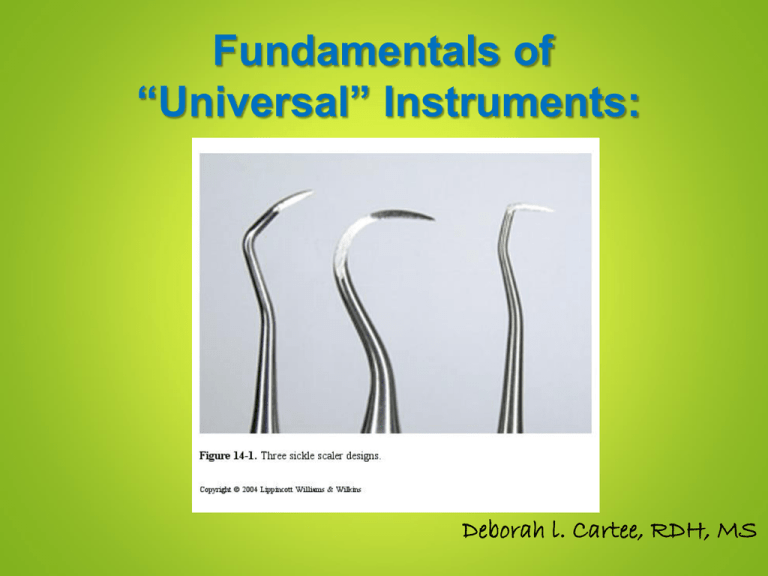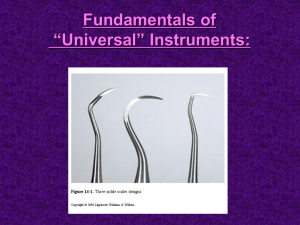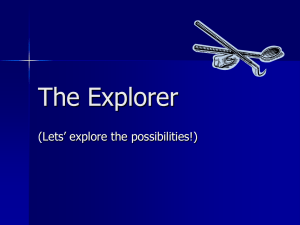Instruments - University of Maryland, Baltimore
advertisement

Fundamentals of “Universal” Instruments: Deborah l. Cartee, RDH, MS Homework Reading Assignments: Wilkins Chapter 38 Darby Chapter 26 Objectives 1. Describe and identify the general characteristics of dental instruments. 2. Discuss variations in instrument shank length, curvature, flexibility, and blade-to-shank angulation. 3. Identify a given instrument by its classification, design, number and manufacturer’s name 4. Select the appropriate instrument for a given task. 5. Discuss proper instrument blade adaptation and angulation. 6. Compare and contrast the metals used in instrument construction. 7. Compare scalers and curettes. Objectives Cont. 8. Compare universal and area specific curet. 9. Describe the distinct characteristics of a scaler. 10. Describe the distinct characteristics of a curet. 11. Determine and descrbe the correct cutting edge for each instrument in the cassette. 12. Demonstrate proper adaptation, insertion, angulation, and activation of each instrument in the cassette. 13. Evaluate successful instrumentation. Instrument Parts Handle Shank – Shape (straight or angled) – Flexibility – Lower or terminal shank Working End- Blade Handle, Shank, Blade Materials Used for Blade Stainless Steel – Metal – Maintains adequate sharpness – Do not rust or discolor Carbon Steel – Metal – Feel sharper clinically and hold their sharpened edges longer – More brittle, can break more easily than SS – Tends to oxidize or rust *Gold “tipped” – Metal – Expensive – Used for Implants *Teflon – Plastic/Graphite reinforced nylon – Only used for Implants *See Darby page 1032-1035 Implant – Teflon Instruments Instrument Handle Overall design – single ended vs. double ended Weight Diameter Surface texture – Serrations Parts of an Instrument Single ended Single ended A = Handle B = Shank C = Working-end Double Ended Design Top instrument (Unpaired) is an example of a curet (on the left) and an anterior sickle on the (right) Bottom instrument (Paired) is an example of a posterior sickle on both ends. Handle Diameters Handle Texture smooth knurled ribbed knurled Working End 2 Types of Universal Instruments: 2 Types of Universal Instruments: 1. Scalers- (in cross-section) pointed tip pointed back supragingival calculus removal 2. Curets - (in cross-section) rounded tip rounded back sub/supragingival calculus removal Face Face To date you’ve learned: *#17 Explorer * ODU Explorer Let’s first talk about the Sickle Scalers Types of Sickle Scalers: Anterior- ‘straight’ shank instrument Posterior- ‘curved’ or multiple shank instrument – (actually can be used universally in the mouth) Terminal shank is at a 90 degree angle to the Face Anterior Sickle Straight Shank Design Characteristics: Basically there are 2 cutting edges at each end. The Face of the Sickle Scaler is at a 90 degree angle to the terminal shank. Flat “face” Terminal shank Note: You do NOT have an anterior sickle scaler in your cassette. You have a “posterior” sickle scaler – 204S (S204S7). We will use this instrument in the anterior and the posterior (universal). We will use this instrument on proximal (mesial and distal) surfaces only. We will NEVER use it on facial and lingual surfaces. Sickle scalers have a pointed tip and two cutting edges on each end of the instrument: Let’s get prepared to scale with the Sickle Scaler – 204S Must maintain side of tip! Correct! Incorrect P. 210 (stool position) (supine, chin & head position) (light, bracket tray) (retraction, mirror) (sickle) (fulcrum) Keep In Mind: Operator and Client Positioning Instrument Blade Selection Grasp Fulcrum (Max. palm up, Mand. palm down) Insertion at 0° Adaptation open to 70°to 80° Angulation- maintain side of tip Please remember: The Sickle instrument is used SUPRAGINGIVAL! (You can go sub about 1-2 mm if necessary, but not more than that!!!) The Sickle instrument will be used Mesial & Distal! (You can NOT use on facial and lingual surfaces!!! ) Start at the Line-angle Anterior Scaler Initial point of insertion is always at the line angle The above shows a straight shanked sickle. Since we will not use this type of instrument, please focus instead on the Terminal Shank and its cutting edges and how it relates to the tooth. Mandibular Anteriors: Buccal Right Handed Clinician 5 6 #27 1. 2. 3. 4. 5. #26 4 #25 3 #24 2 #23 1 #22 From a 11:30 position, insert at the Distal Buccal Line Angle of #22 (tip towards the col) Initiate walking stroke towards and into the distal col. Remove at end of pull stroke Reinsert at the Mesial Buccal Line Angle of #22 (tip towards the mesial col) Initiate walking stroke toward and into the mesial col. Remove at end of pull stroke Move onto #23 D and then #23 M, then #24D, #24 M, etc. Mandibular Anteriors: Lingual Right Handed Clinician #22 1. 2. 3. 4. 5. #23 #24 #25 #26 #27 From a 11:30 position, insert at the Distal Lingual Line Angle of #22 (tip towards the col) Initiate walking stroke towards and into the distal col. Remove at end of pull stroke Reinsert at the Mesial Lingual Line Angle of #22 (tip towards the mesial col) Initiate walking stroke toward and into the mesial col. Remove at end of pull stroke Move onto #23 D and then #23 M, then #24D, #24 M, etc. Mandibular Anteriors: Buccal Left Handed Clinician 5 6 #27 1. 2. 3. 4. 5. #26 4 #25 3 #24 2 #23 1 #22 From a 12:30 position, insert at the Distal Buccal Line Angle of #27 (tip towards the col) Initiate walking stroke towards and into the distal col. Remove instrument at upward stroke Reinsert at the Mesial Buccal Line Angle of #27 (tip towards the mesial col) Initiate walking stroke toward and into the mesial col. Remove instrument at upward stroke Move onto #26 D and then #26 M, then #25D, #25 M, etc. Mandibular Anteriors: Lingual Left Handed Clinician #22 1. 2. 3. 4. 5. #23 #24 #25 #26 #27 From a 12:30 position, insert at the Distal Lingual Line Angle of #27 (tip towards the col) Initiate walking stroke towards and into the distal col. Remove at end of pull stroke Reinsert at the Mesial Lingual Line Angle of #27 (tip towards the mesial col) Initiate walking stroke toward and into the mesial col. Remove at end of pull stroke Move onto #26 D and then #26 M, then #25D, #25 M, etc. Stroke Sequence for Posterior Teeth: 2 1 2 1 2 1 2 1 2 Notice that you will begin your working stroke at the Distal Line Angle (1) and proceed into the distal col. You will then reinsert tip at the Mesial Line Angle (2) (tip now pointing towards the Mesial). Remember, Terminal shank of instrument is parallel to the line angleproceed with walking stroke into the mesial col area. Auxiliary Shank Terminal Shank Correct working end: Incorrect working end: Auxiliary Shank Terminal Shank Working End Correct! Incorrect Working End Correct! Incorrect Angulation Correct Angulation- 70°to 80° Burnished Calculus – < than 70° Angle <45° Angle >90° Incorrect angulation- 90° Why is this a problem? Start at the distal line-angle with the tip facing distally. Do Not use the sickle on direct buccal/lingual surfaces!!! Walking Sequence (per quadrant): Midline (limited radius) 1. 2. For Right 1. Handed Clinicians: 2. 2. 1. 2. 2. 2. 2. 2. 2. 2. 2. 2. Notice that operator position and the direction of the instrument handle changes at the canine on the dominant side. 1. 2. 1. 1. 2. 2. 1. 1. 2. 1. 2. 1. 2. 2. Walking Sequence (per quadrant): Midline (limited radius) 1. 2. 2. For Left 2. Handed Clinicians: 2. 2. 2. 2. 1. 2. 2. 1. 2. 1. 2. Notice that operator position and the direction of the instrument handle changes at the canine on the dominant side. 2. 2. 1. 1. 2. 1. 2. 2. 1. 1. 2. 1. 2. 1. Summary You will be using the Posterior Sickle on ALL proximal surfaces in the mouth. When you are scaling only the anterior teethplease follow the sequence in slides (slides #44-45) When scaling posterior and anterior teeth in a single session- instrumentation sequence is: quadrant at a time! (slides #44-45) In Review You Should ALWAYS Keep in Mind: Lateral Pressure Strokes Stroke Direction Stroke Length Reinforcement Now, Let’s take a look at the Universal Curet The Universal curet is similar to the Sickle in that it also has two cutting edges per end. The difference between them is that the tip of the Universal curet is rounded- not pointed like the Sickle. This allows you to use this instrument SUBGINGIVAL!!! Universal Curets: Scalers - (in cross-section) pointed tip pointed back supragingival calculus removal Curets - (in cross-section) rounded tip rounded back sub & supragingival calculus removal Universal Curets Columbia 13/14 (SC13/147) Barnhardt Younger Good Blade size, shank length and design will determine preferred area usage. So, Let’s Keep in Mind. . . Fulcrum rest must be near, but not directly over the surface being scaled (fulcrum on same arch). Determine correct working end of instrument: Terminal shank parallel to MESIAL line angle of molar Foot of instrument curves towards the tooth Angle for insertion is 0-40 (closed blade) Oblique Stroke Continued. . . . With closed blade, insert subgingival to JE- lateral pressure should be fairly light. Open angle to 45-90° (subgingival) and initiate exploratory stroke (pull stroke) Lateral pressure against tooth should remain fairly light unless a ‘bump’ is felt. Return back to JE and apply firmer pressure during pull stroke to remove ‘bump’ calculus? Fulcrum pressure increases during pull stroke Continued. . . Relax fingers during exploratory stroke Apply greater lateral pressure during pull stroke. Strokes should be short and controlled, with moderate pressure from the base of the pocket, toward the gingival margin. Stroke direction – vertical, oblique & horizontal (overlapping) remaining primarily in the gingival sulcus. Please remember… You should ALWAYS scale a tooth to completion!!! That means: Look at the clock and budget your time!!! How long will it take you to scale a lingual/buccal surface? Dependent on : How ‘heavy’ the calculus is How ‘tenacious’ the calculus is How good is your technique? Then determine how many teeth you can scale thoroughly and completely with the amount of time you have. . . Cutting Edges Adaptation Incorrect 90°Angulation






